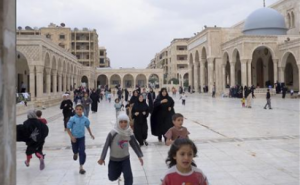 Snipers in Damascus. Soldiers shooting protesters. Clashes outside a military camp.
Snipers in Damascus. Soldiers shooting protesters. Clashes outside a military camp.
The allegations of violence by the Syrian opposition came just hours after a temporary cease-fire was to have taken hold on Friday, dimming hopes that the killings that have wracked Syria could be halted.
Observers have been skeptical about the truce negotiated by U.N.-Arab League envoy Lakhdar Brahimi would hold give that an effort in April by his predecessor failed within hours.
On Friday, Brahimi’s temporary truce appeared to be headed toward the same fate.
Thousands of people poured into the streets across Syria, using the start of the four-day truce that coincides with the revered Muslim holiday of Eid al-Adha as an opportunity to protest against President Bashar al-Assad’s rule.
The four-day religious holiday of Eid al-Adha begins at the height of the Hajj — the pilgrimage to Mecca in Saudi Arabia that annually draws 2 million Muslims. It is a time where Muslims gather with family and friend.
But within hours, reports of violence began to emerge, according to the opposition:
— At least 19 people were killed across Syria on Friday after the cease-fire was to be in place
— At least three people were killed in tank and sniper fire in a Damascus suburb where government forces have been battling rebel forces on-and-off for control.
— Fierce fighting broke out between government forces and the al Qaeda-linked al Nusra Front, which said earlier it would not abide by the terms of the temporary truce.
The al Nusra fighters laid siege to military encampment east of the city of Maaret al-Numan.
— Government forces shelled a neighborhood in the flashpoint city of Homs where the opposition alleged six rockets fell, wounding two people and damaging a number of buildings.
— At least three people sustained gunshot wounds when Syrian forces fired shots in the air in an attempt to disperse protesters in the town of Inkhil in Dara province.
CNN can’t confirm reports of violence as the Syrian government has severely restricted the access of international journalists.
The negotiated truce is the latest international effort to end the bloodshed in Syria where some 32,000 people, according to the opposition, have been killed in fighting that began in March 2011.
Here are the key developments:
The terms of Syria’s agreement have raised skepticism among some observers: Damascus reserves the right to respond to “terrorist” attacks, including bombings, as well as “terrorists” trying to reinforce their positions; and to protect neighboring borders crossed by “terrorists.”
On the rebel side, a top Free Syrian Army general said Thursday his fighters had agreed to halt military operations if the Syrian government were to do so as well. But he said he doubted that the truce would hold.
Syria’s rebel opposition is fractured, and Gen. Mustafa al-Sheikh said that some rebel groups have not agreed to halt operations.
The government, meanwhile, touted its several goodwill efforts Thursday leading to its announcement that it will stop fighting.
State-run TV aired footage of men walking out of a prison — part of a government amnesty program, a commentator said.
The release comes a week after rebel fighters told Al Jazeera news agency that they would agree to a proposed cease-fire only if the government were to release detainees, end a siege in the city of Homs and halt aerial attacks.
‘Foolish to expect total cease-fire’
It’s foolish to expect a total cease-fire, said Aram Nerguizian, a Middle East expert at the Center for Strategic and International Studies in Washington.
A cease-fire in this context is about a larger goal of getting most rebel brigades and al-Assad forces to halt or reduce the killing.
CNN
photo: Displaced Syrians, who fled the violence in their homes due to incessant clashes between Free Syrian Army fighters and forces loyal to Syria’s President Bashar al-Assad, are seen living in a mosque in Aleppo October 23, 2012. REUTERS/George Ourfalian

Leave a Reply
You must be logged in to post a comment.